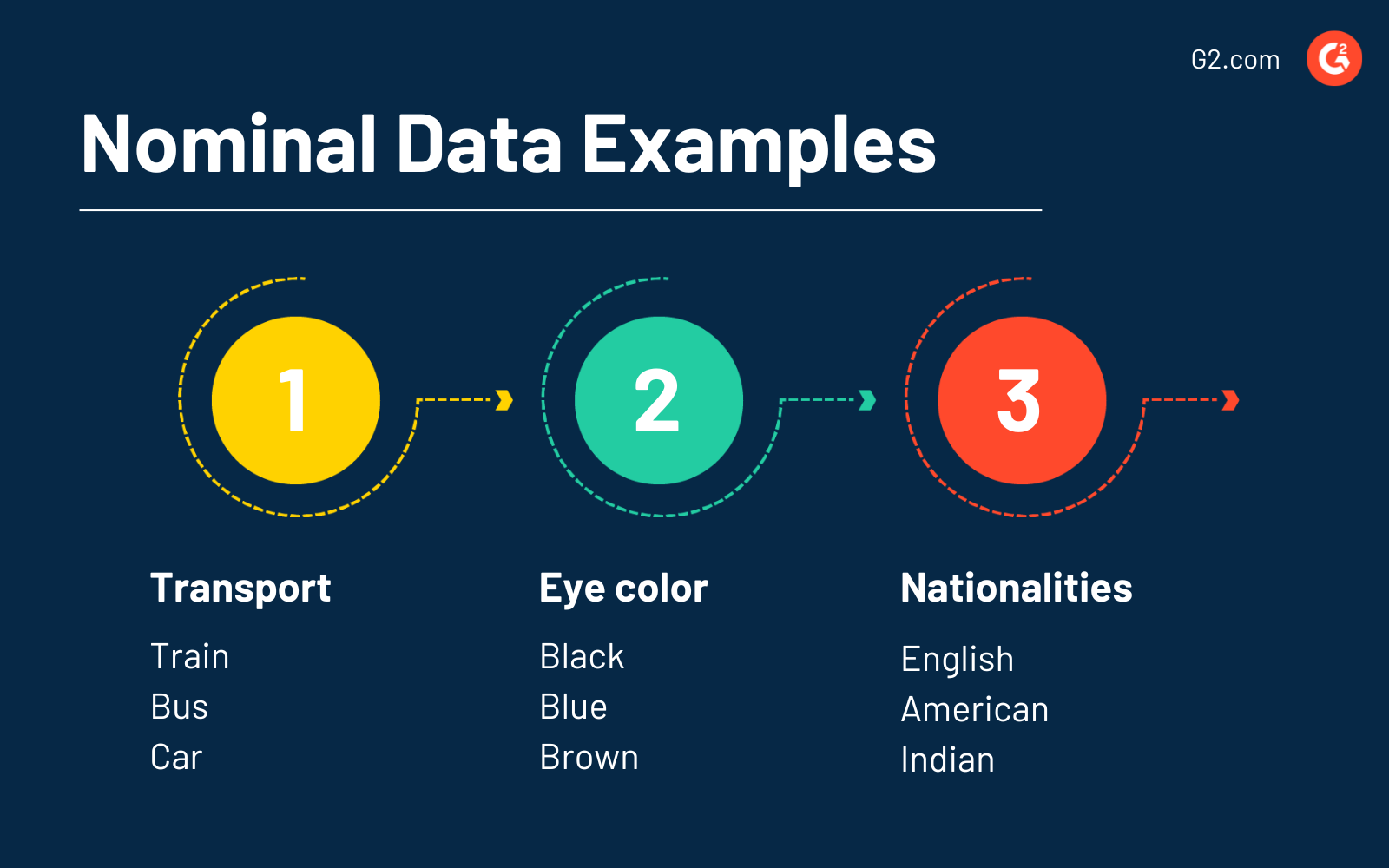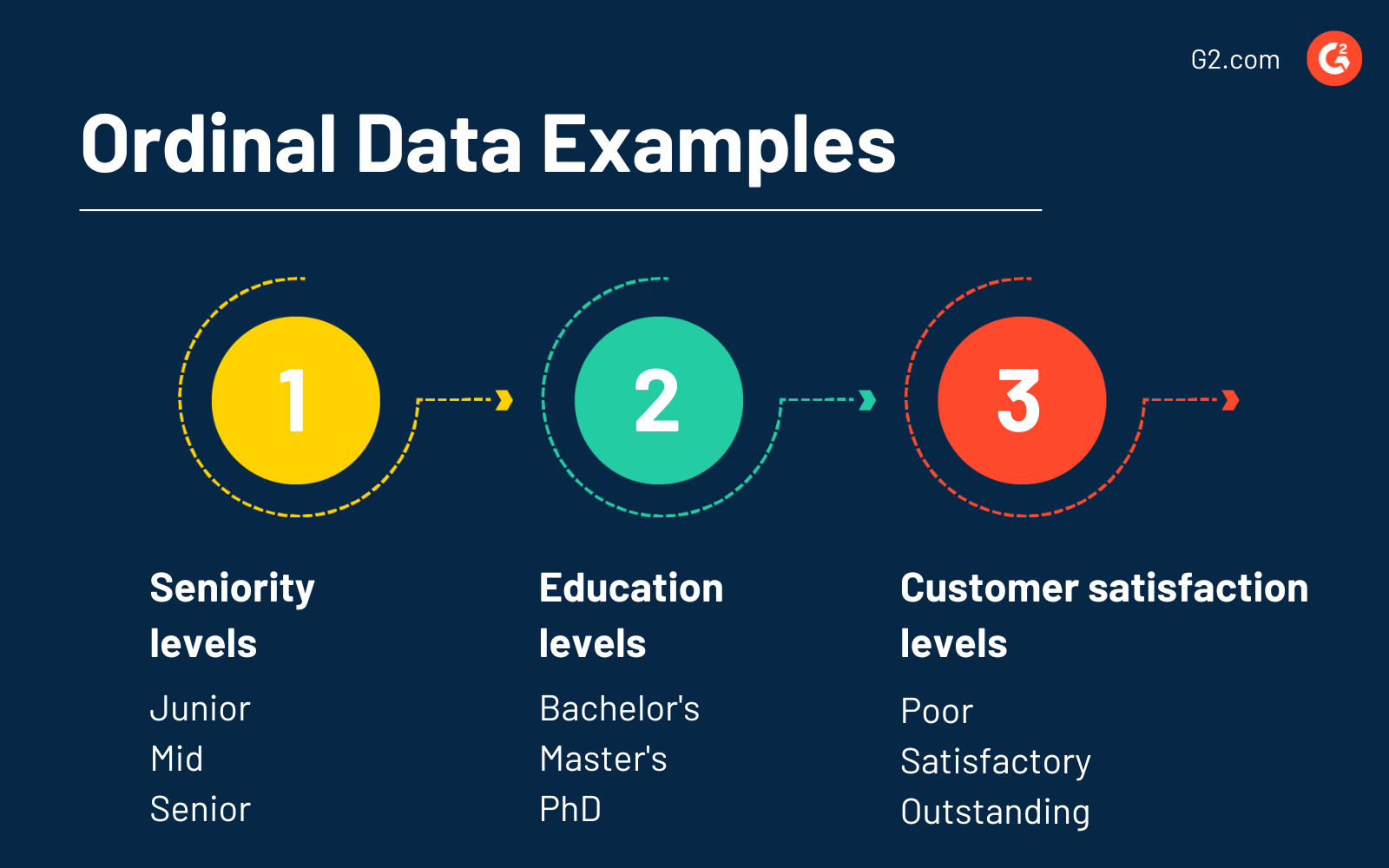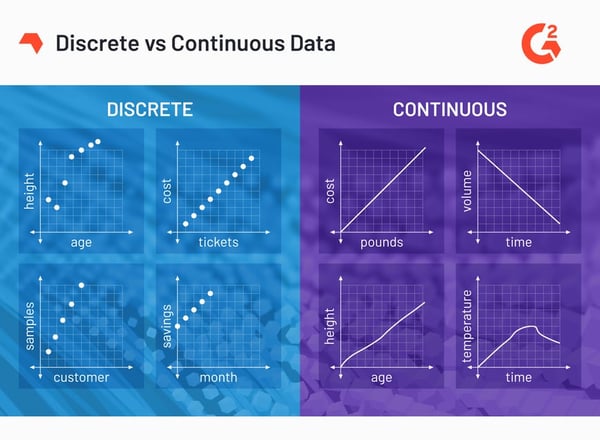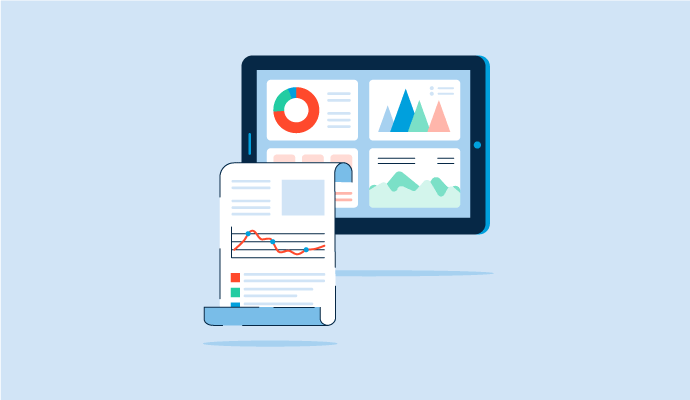Data analysis is broad, exploratory, and downright complex.
But when we take a step back and attempt to simplify data analysis, we can see it boils down to these two: qualitative vs. quantitative data. The main difference between them is that: quantitative data is measurable, whereas qualitative data is descriptive. These two data types are different yet make up all the data you'll ever analyze.
Before you analyze data using statistical analysis software, it's essential to understand the key differences between qualitative and quantitative data.
What is the difference between qualitative and quantitative data?
Quantitative data can be counted, measured, and expressed using numerical values. Qualitative data is descriptive and conceptual. Qualitative data can be categorized based on traits and characteristics.
The key difference is that quantitative data is fixed or universal, whereas qualitative data is subjective. For example, if a ball weighs 30 pounds or 13.6 kilograms, it's an objective fact about the ball. This kind of data is to-the-point and conclusive. Qualitative data is subjective, interpretive, and exploratory. For example, two people can interpret an event differently based on their lived experiences.
So, which is which? Now that we have the differences, let's dive into each data type using real-world examples.
What is qualitative data?
Qualitative data is non-statistical and is typically unstructured or semi-structured. This data isn't necessarily measured using hard numbers you use to develop graphs and charts. Instead, it is categorized based on properties, attributes, labels, and other identifiers.
Qualitative data can be used to ask the question, 'why'. It is investigative and asks open-ended questions to conduct the research. Generating this data from qualitative research is used for theorizations, interpretations, developing hypotheses, and initial understandings.
Qualitative data examples
To better understand qualitative data, let's take the example of a bookcase. The following characteristics of this bookcase determine the quality of the information that's available to us about it:
- Made of wood
- Built in Italy
- Deep brown
- Golden knobs
- Smooth finish
- Made of oak
When discussing qualitative data, we talk about a specific object's characteristics. Qualitative data is derived through qualitative analysis of detailed information about the matter.
With a bookcase, there are many ways to get qualitative information from different observers. If someone doesn't have specific details on the bookcase, they can assume that it's made of teak, not oak, and has a rough surface, not smooth. Likewise, we can also discuss what type of oak it's made of or what part of Italy it came from.
Thus, qualitative data identifiers can be subjective, making qualitative data analysis a complex process with numerous possibilities and structures.
Real-world examples of qualitative data:
- Product reviews
- Interview transcripts
- Texts and documents
- Customer testimonials
- Focus group responses
- Notes and observations
- Audio and video recordings
- Survey and questionnaire labels and categories
Möchten Sie mehr über Textanalyse-Software erfahren? Erkunden Sie Textanalyse Produkte.
What is quantitative data?
Contrary to qualitative data, quantitative data is statistical and typically structured – meaning it is more rigid and defined. This data type is measured using numbers and values, making it a more suitable candidate for data analysis.
Whereas qualitative is open for exploration, quantitative data is much more concise and close-ended. It can be used to ask 'how much' or 'how many,' followed by conclusive information.
Quantitative data examples
Let’s look at what a quantitative data set looks like for the bookcase. Imagine the bookcase is 3 feet long, weighs 100 pounds, and costs $1500 — all these are quantitative data about the bookcase.
Real-world examples of quantitative data:
- Calculations (annual revenue)
- Measurements (height, width, and weight)
- Counts (the number of people who signed up for the webinar)
- Projections (predicted revenue increase as a percentage during a fiscal year)
- Quantification of qualitative data (customer satisfaction score calculation based on ratings on a scale of 1 to 5)
Here is a video that explains qualitative and quantitative data.
Source: Jotform
Qualitative vs. quantitative data: Key differences
This section will walk you through qualitative and quantitative data types, research methods, and analysis tools. But first, let’s look at the major difference between qualitative and quantitative data.
Qualitative data is non-numerical data that researchers use to interpret how individuals perceive and find meaning in their social reality. Quantitative data is numerical data that analysts use to find relationships between variables and predict results. It provides a conclusive statistical picture behind a trend.
The key difference is that: qualitative data answers the ‘why’ behind a correlation or phenomenon, whereas quantitative data answers the ‘what’ and ‘how’ of a behavior.
| Qualitative data | Quantitative data | |
| Definition | Descriptive and non-numerical data that explains the ‘why’ behind a phenomenon | Countable, measurable, and number-based data that quantifies correlations into hard facts |
| Aim | To explore a phenomenon | To confirm a hypothesis |
| Analytical objective | To describe and explain relationships and variations between variables | To quantify variations, predict results, and generalize characteristics of a population |
| Data collection methods | Semi-structured methods like in-depth interviews, focus groups, and participant observation | Highly structured data collection methods such as surveys and questionnaires |
| Data types | Ordinal data and nominal data | Discrete data and continuous data |
| Data format | Textual | Numerical |
| Question format | Open-ended survey | Closed-ended survey |
| Analysis tools | Manual theme or sentiment analysis | Charts, tables, and statistical programs |
| Best for | Conducting large-scale studies that aim to find trends or traits around a phenomenon | Formulating and verifying hypothesis around a correlation |
Types of qualitative and quantitative data
In this section, we explore different types of qualitative and quantitative data.
Types of qualitative data
There are two basic qualitative data types: ordinal and nominal.
1. Ordinal data
Ordinal data refers to non-numeric, qualitative data that groups variables into categories based on the natural order or hierarchy of data. For example, customers can choose from poor, satisfactory, good, and outstanding while ranking a product or service. While this hierarchy doesn’t quantify the data, you still get a rough idea of customer sentiment around your product.
Ordinal data can also contain numerical figures. In such cases, numbers categorize levels and have no inherent mathematical value. For example, you can label poor, satisfactory, good, and outstanding as 1, 2, 3, and 4. So, the numbers create a rating scale for capturing different customer satisfaction levels.
Ordinal data features:
- Places data into a hierarchy or order.
- Is non-numeric but can be categorized using data labeling software.
- Doesn’t have an even distribution despite the scale.
- Is calculated using frequency distribution, mode, median, and range of variables.
2. Nominal data
Nominal data labels variables into mutually exclusive categories without assigning them quantitative values. You can't order or measure nominal data like ordinal data.

For example, daily commuters can be divided into three categories based on their mode of transport, i.e., bus, train, and car. But you can't create a meaningful order of hierarchy with this kind of data.
Nominal data features:
- Places data into mutually exclusive categories.
- Uses descriptive labels that have no quantitative values.
- Can't be arranged into a meaningful order of hierarchy.
- Can be calculated using mode, frequency distribution, and statistical tests.
Types of quantitative data
1. Discrete data
Discrete data is data that you can't break down into smaller parts. This data type consists of integers (positive and negative numbers, e.g., -100, 10, 100, and so on) and is finite (meaning it reaches a limit).
A few examples of discrete data would be how much change you have in your pocket, how many iPhones were sold last year, and how much traffic came to your website today.
Another important note is that discrete data can technically be categorical. For example, the number of baseball players in a team born in Mexico is whole and discrete.
2. Continuous data
Continuous data is data that can be infinitely broken down into smaller parts or data that continuously fluctuates. A few examples of continuous data would be the speed of your train during the morning commute, the time you take to write an article, your weight, and your age.
Qualitative and quantitative research
One major difference between qualitative and quantitative data is how it is collected. This section explores the different qualitative and quantitative data collection methods.
Qualitative data collection methods
Qualitative research focuses on qualitative data collection methods to study and observe a target audience and draw conclusions from the data collected. This research method relies more on subjective characteristics determined by qualitative approaches.
Focus groups
The focus group research method is one of the most widely used qualitative research methods in data collection. A focus group consists of a certain number of respondents (5-10) who act as a cluster. You can also use survey tools to send a questionnaire to a focus group, get their feedback or opinion on a specific issue, and record their responses for quick data analysis.
Forming and managing focus groups can be a complex and costly process. It's used by companies that may want to launch a new product to study the market and gain insight into their target audience's needs, preferences, and behavioral traits.
Ethnographic research
Ethnographic research involves observing and studying research topics in a specific geographic location. This geographic location can range from a small entity to countries across the globe. Ethnographic research helps researchers learn cultures, behaviors, trends, and pain points in a natural setting. Again, this research method is time-consuming and challenging and can extend beyond a specific period.
Case study
A case study is an in-depth analysis primarily used in the social and educational sciences. Any organization, large or small, can do it to draw a detailed inference on a topic. A case study is also one of the most straightforward but time-consuming research methods involving data collection from multiple sources.
Narrative
The narrative research method relies on developing or creating a story. You put together a series of events and create a narrative around an observed topic. This investigation method shows how a small entity can affect a significant event and determine its relationship.
Phenomenology
Phenomenology is another research method that considers a specific event or phenomenon for qualitative data collection. It helps an observer understand how, why, and what phenomenon occurs and its impact on the issue. Phenomenology uses various data collection methods, from documents, videos, and interviews to visiting a place, experiencing the phenomenon, and describing how it has evolved and developed over time.
Grounded theory
Grounded theory focuses on explaining the reasoning behind an event's occurrence. The sample size used for grounded theory is usually below a hundred subjects and evaluates how something happens at a given time.
Now is the time to get SaaS-y news and entertainment with our 5-minute newsletter, G2 Tea, featuring inspiring leaders, hot takes, and bold predictions. Subscribe below!
Quantitative data collection methods
Quantitative research relies on numerical and statistical analysis method, which uses numbers and statistics to make reasonable and definite deductions. Here are some of the standard quantitative research methods.
Correlation research
A correlation research method studies the relationship between two or more similar and interdependent variables. It shows how one variable affects the other and vice versa. Correlation research uses mathematical analysis to analyze collected data. The results can be presented in a diagram or generated in statistics to complete the research results.
Experimental research
An experimental research method is a theoretical research approach. It focuses on a theory to distinguish between right and wrong statements. This research method helps verify an argument and is mainly used in the natural sciences.
Causal-comparative research
A causal-comparative compares two variables that are not related. One is dependent, and the other is independent. Also known as quasi-experimental research, it determines the cause-and-effect relationship between these variables.
Survey research
Survey research is one of the most widely used research methods in education, politics, economics, and more. Organizations use it to gather product feedback from random respondents through surveys, questionnaires, and other input methods. The data collected is then analyzed to obtain quantitative results.
Qualitative vs. quantitative data: Analysis methods
Another critical factor that differentiates qualitative and quantitative data is how you analyze them. Statistical analysts group qualitative data into different themes to find meaningful categories, whereas quantitative data uses mathematical calculations to draw conclusions.
Qualitative data analysis
Qualitative data analysis (QDA) organizes and interprets non-numeric, conceptual data to discover themes and answer research questions. Since there’s no way to measure qualitative data objectively, it’s open to subjective interpretation. Below are some of the common qualitative data analysis methods.
- Content analysis uses text analysis software to uncover quantitative insights from qualitative data. It does so by quantifying the presence of certain concepts and subjects in audio/video messages, images, and texts.
- Thematic analysis finds common themes and summarizes qualitative data patterns across texts. Unlike content analysis, it can be used for qualitative data only.
- Narrative analysis interprets testimonials, interviews, case studies, and other research participant stories to gain insights into behaviors and feelings.
- Grounded theory analysis aims to formulate theories by creating and testing hypotheses with qualitative data.
- Discourse analysis uses different observation techniques to establish relationships between textual or audio-visual information and its context.
Now, let’s look at quantitative data analysis methods.
Quantitative data analysis
Quantitative data analysis uses various methods, depending on the data at hand. The ultimate goal remains the same, though — to find data trends and discover relationships between a set of variables. Below are some of the commonly used quantitative data analysis methods.
- Regression analysis tests the relationship between dependent and independent variables.
- Monte Carlo simulation aims to predict the probabilities of an uncertain event based on past data and a choice of action.
- Factor analysis creates fewer factors from a large number of variables to describe variability among correlated variables.
- Cohort analysis is a behavioral analytics tool. It analyzes traits of a cohort or a group of individuals with shared characteristics to understand their actions and usage patterns.
- Cluster analysis organizes items into groups of clusters to understand the association among them.
- Time series analysis uses data visualization techniques to showcase the systematic pattern changes between dependent and independent variables over time.
Advantages and disadvantages of quantitative and qualitative data
Quantitative data is easy to collect, but it can lack context. For example, you can run a quick survey to understand that 35% of customers are unhappy with your product or service. But you can’t probably know what’s causing their dissatisfaction. That’s why quantitative data is an excellent choice for drawing generalizable conclusions but doesn’t give you the complete picture behind a phenomenon.
Qualitative data, on the other hand, provides in-depth insights and contextual information about a phenomenon. For example, you can use qualitative data analysis tools to understand the sentiment, traits, and opinions of that 35% of customers who aren’t happy with your product. The only disadvantage is that it takes time to collect qualitative data. Moreover, there are greater chances of bias since qualitative data is open to interpretation.
| Qualitative data | Quantitative data | |
| Advantages |
|
|
| Disadvantages |
|
|
What’s better for data analysis: qualitative or quantitative?
Now that we have broken down the bread and butter of qualitative and quantitative data, it’s time to consider which type is better for data analysis.
Qualitative data will almost always be considered unstructured or semi-structured data. This type of data is loosely formatted with very little structure. Because of this, qualitative data cannot be collected and analyzed using conventional methods.
Making sense of qualitative data can be time-consuming and expensive, although some methods of “structuring” this data. For example, one could apply metadata to describe an unstructured data file. Alt-text is a type of metadata applied to image files to assist search engines like Google, Bing, and Yahoo with indexing relevant images.
The rise of NoSQL databases has made the collection and storing of qualitative data much more manageable. However, it’s still an upward climb before being able to harness this data completely.
Quantitative data will almost always be considered structured data. This type of data is formatted in a way so it can be quickly organized and searchable within relational databases. Perhaps the most common example of structured data is numbers and values found in spreadsheets.
Because quantitative data and structured data go hand-in-hand, quantitative data is generally preferred for data analysis.
When to use qualitative vs. quantitative data
- Qualitative data for analyzing opinions, sentiments, or experiences
- Quantitative data for testing or confirming a hypothesis
- A mixed methods approach for complex research requirements
Frequently asked questions about qualitative and quantitative data
1. What is the difference between qualitative and quantitative research?
Qualitative research is exploratory. It collects and analyzes non-numerical data to understand the reasons behind opinions, experiences, motivations, and sentiments. Quantitative research analyzes numerical data to find relationships between variables. It is more objective and structured than qualitative research.
2. What are some qualitative and quantitative data examples?
Qualitative data is descriptive and subjective. Common examples include:
- Reviews
- Interview transcripts
- Texts and documents
- Customer testimonials
- Focus group responses
- Observational notes
- Audio and video recordings
Quantitative data is numerical and objective. Common examples include:
- Numerical survey responses
- Test scores
- Measurements and counts
- Calculations
- Projections
How well do you know the difference?
To strengthen your understanding of qualitative and quantitative data, think of a few ways in your life to apply both. Start with yourself as an example. To acquire qualitative data, consider identifiers like the color of your clothes, type of hair, and nose shape. Consider measurable values like height, weight, age, and shoe size for quantitative data.
With a firm grasp of qualitative and quantitative data, you can begin making sense of the data analysis process.
This article was originally published in 2021. It has been updated with new information.

Devin Pickell
Devin is a former senior content specialist at G2. Prior to G2, he helped scale early-stage startups out of Chicago's booming tech scene. Outside of work, he enjoys watching his beloved Cubs, playing baseball, and gaming. (he/him/his)




